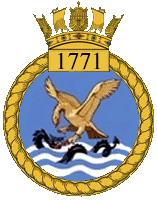| 1771 Naval Air Squadron | |
|---|---|
 1771 NAS badge | |
| Active | 1 February 1944 - 16 October 1945[1] |
| Country | |
| Branch | |
| Type | Two-seat fighter squadron |
| Role | Fighter Squadron |
| Size | twelve aircraft |
| Part of | Fleet Air Arm
|
| Home station | See Naval air stations section for full list. |
| Engagements | World War II |
| Battle honours |
|
| Insignia | |
| Squadron Badge Description | Blue, a base barry wavy of six white and blue an eagle gold in combat with a sea monster black issuant from base armed and langued red (1944)[2] |
| Identification Markings | single letters 4A+ (September 1944) 270-281 (July 1945)[3] |
| Tail Code | N (July 1945) |
| Aircraft flown | |
| Fighter | Fairey Firefly |
1771 Naval Air Squadron (1771 NAS) was a Naval Air Squadron of the Royal Navy's Fleet Air Arm which disbanded at HMS Nabbington, RNAS Nowra, near Sydney, in October 1945. Notably, the squadron was the first British & Commonwealth unit to fly over Japan in the Second World War.[4] The squadron formed at HMS Heron, RNAS Yeovilton at the start of February 1944, as a Fighter Squadron and also operated from HMS Ringtail, RNAS Burscough, and HMS Landrail, RNAS Machrihanish, with deck landing training on the escort carriers HMS Trumpeter and HMS Ravager before embarking in the fleet carrier HMS Implacable in September. It was involved in sorties over Norway including reconnaisance of the German battleship Tirpitz and other anti-shipping strikes. The squadron remained in HMS Implacable and joined the British Pacific Fleet participating in attacks on the Caroline islands and the Japanese home islands, and becoming part of the 8th Carrier Air Group.
- ^ Sturtivant & Ballance 1994, p. 339.
- ^ Ballance, Howard & Sturtivant 2016, p. 278.
- ^ Wragg 2019, p. 190.
- ^ "Crews of the First British Aircraft to Fly over Japan. July 1945, in the British Escort Carrier HMS Implacable. On 17 July 1945 Fairey Firefly Fighters of 1771 Squadron Operating from Implacable Became the First Aircraft of the Fleet Air Arm to Fly over Japan".